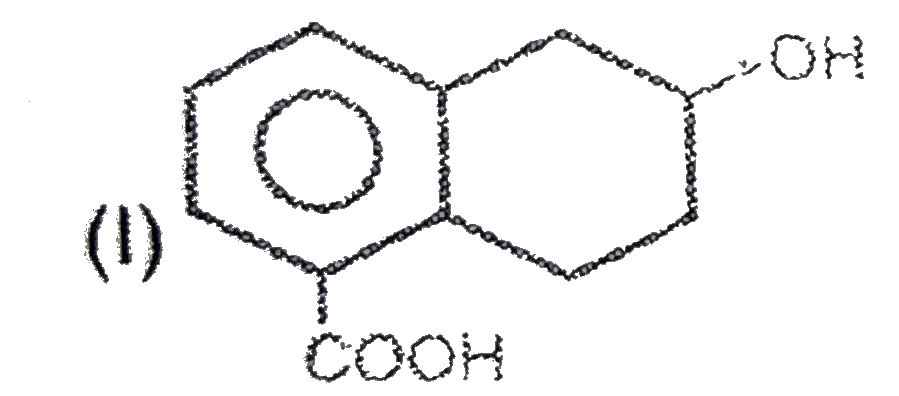The following two compounds I and II can be distinguished by using reagent
 " "
" " 
(a) aq. NaHCO3 " " (b) Neutral FeCl3
(c ) Blue litmus solution " " Na metal " " (e) HCl/ZnCl2 anhydrous
a or c
b or e
d or e
c or d
The correct Answer is:B
(a) Both give the test with aq. NaHCO3 because both have −COOH group and acidic hydrogen.
(b) II give +ve test with neutral FeCl3 due to presence of phenolic −OH group, but (I) does not.
( c) In(I) and (II) acidic hydrogen atom is present so both give +ve test with blue litmus solution.
(d) In (I) and (II) acidic hydrogen atom is present so both give +ve test with Na metal.
(e) (I) give +ve test with HCl/ZnCl2 due to presence of aliphatic alcoholic group, but (II) does not.
Topper's Solved these Questions
- BOOK - RESONANCE ENGLISHCHAPTER - STRUCTURAL IDENTIFICATIONEXERCISE - Exercise - 2 (Part-I)10videos
STRUCTURAL IDENTIFICATION
- BOOK - RESONANCE ENGLISHCHAPTER - STRUCTURAL IDENTIFICATIONEXERCISE - Exercise - 2 (Part-II)8videos
STRUCTURAL IDENTIFICATION
- BOOK - RESONANCE ENGLISHCHAPTER - STRUCTURAL IDENTIFICATIONEXERCISE - Exercise-1 (Part-I)23videos
STRUCTURAL IDENTIFICATION
- BOOK - RESONANCE ENGLISHCHAPTER - STEREOISOMERISMEXERCISE - EXERCISE (PART III : PRACTICE TEST-2 (IIT-JEE (ADVANCED PATTERN))23videos
STEREOISOMERISM
- BOOK - RESONANCE ENGLISHCHAPTER - SURFACE CHEMISTRYEXERCISE - Section - 51videos
SURFACE CHEMISTRY
Similar Questions
The following two compounds I and II can be distinguished by using reagent

(a) aq. NaHCO3 , Neutral FeCl3
(b) Blue litmus solution , Na metal
(c) HCl/ZnCl2 anhydrousView SolutionThe following two compounds I and II can be distinguished by using reagent

(1)Aq.NaHCO3 , (2)Neutral FeCl3(aq.)(FeCl3+NH4OH+H2O)
(3)Blue litmus solution , (4)Na metal
(5)HCl+ZnCl2(anhydrous)View SolutionAcetaldehyde and Propyne can be distinguish by :
(i) Tollen's reagent " " (ii) l2/NaOH " " (iii) Lucas reagent " " (iv) neutral FeCl3View SolutionCompounds I and II can be distinguished by using reagent.
I II4-Amino-2methylbut-3-en-2ol4-Amino-2,2-dimethylbut-3-yn-1-olView SolutionCompounds I and II can be distinguished by using reagent.
(I)(II)4-Hydroxy-4-methypent-2-enoic acid5-Hydroxypent-2-ynoic acidView SolutionThe pair of compounds which cannot exist together in aqueous solution is:
(I)NaH2PO4 and NaHCO3 (II)Na2CO3 and NaHCO3
(III)NaOH and NaH2PO2 (IV)NaHCO3 and NaOHView SolutionThe pairs of compounds which cannot exist together in aquous solution are:
(I)NaH2PO4andNa2HCO3 (II)Na2CO3andNaOH
(III)NaOHandNaH2PO4 (IV)NaHCO3andNaOHView SolutionWhich of the following compounds after mixing can produce blue colouration?
(I) K4[Fe(CN)6]andFeCl3 solution
(II) NH4OHandCuSO4 solution
(III) Adding anhydrous CuSO4 to water
(IV) NH4OH+NiSO4 solution
Choose the correct code:View SolutionFive isomeric p-subsituted aromatic compounds (A) to (E ) with molecular formula C8H8O2 are given for identifyication. Based on the following observation, give the structures of the compounds.
i. Both (A) and (B) form a silver mirror with Tollens reagent, (B) also gives a positive test with neutral FeCl3 solution.
ii. (C ) gives positive iodoform test.
iii. (D) is readily extracted in aqueous NaHCO3 solution.
iv. (E ) on acid hydrolysis gives 1,4-dihydroxy benzene.
Compound (A) is:View SolutionFive isomeric p-subsituted aromatic compounds (A) to (E ) with molecular formula C8H8O2 are given for identifyication. Based on the following observition, give the strucctures of the compounds.
i. Both (A) and (B) form a silver mirror with Tollens reagent, (B) also gives a positive test with neutral FeCl3 solution.
ii. (C ) gives positive iodoform test.
iii. (D) is readily extracted in aqueous NaHCO3 solution.
iv. (E ) on acid hydrolysis gives 1,4-dihydroxy benzene. Compound (E ) is:View Solution

